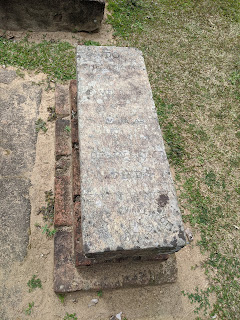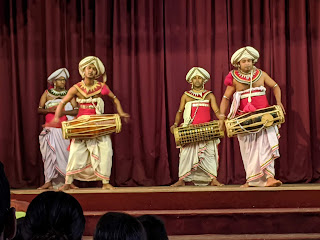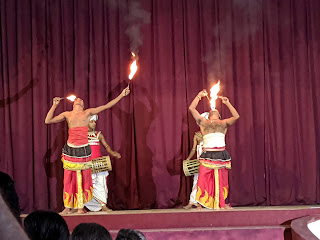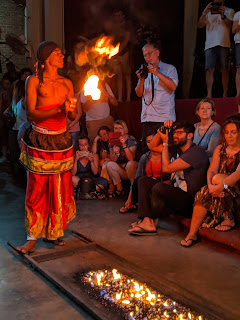What a great decision we'd made to stay for our first two nights at The Steuart by Citrus Hotel in Colombo, Sri Lanka, as it was not only in an ideal location close to restaurants and sights but its large room was very welcoming after two overnight flights from Denver.
He explained that Prince Charles had planned to visit the cemetery in 1998 but had to delay it until 2013 because of a bomb blast. Before the prince's arrival, Carmichael and 20 others worked for a year to reclaim the graves from the nearby jungle.
The cemetery was located at the base of a large hill that was very popular with wild pigs. Within one week of Charles' visit, the caretaker told us that the cemetery was sent 5,000 English pounds sterling to rectify the problems caused by the wild pigs who loved to run down the hill and dig up the bones. When we glanced up the hill we could still see lots of wild pigs who luckily could no longer reach the graves!
In the former cemetery's chapel, now a museum, Charles showed us the large tome listing all the British soldiers that were buried throughout Sri Lanka and with a lengthy description of each one. It seemed that Charles had memorized all those buried in the British Garrison Cemetery! We have been in so, so many cemeteries on our travels around the world but never had we been treated to a personal tour of many of the graves as we had been by Charles.
The Drum Orchestra had five categories of traditional instruments which were usually played three times a day in places of worship as a tribute to Lord Buddha. It was also played in honor of royalty. The varying beats of the different drums blended together in perfect unison and harmony.
The second part of the performance was Puja Natuma in which women carried oil lamps to make an offering or puja of their dancing skills to the deities. Natuma meant dance. The women's movements were so very gracious, I felt like a klutz watching them!
One of the most thrilling dances up to that point was the Panatheru Natuma, a dance that was named after the panteru, the instrument similar to a tambourine used in the dance. The dance showed Sinhala warriors on their way to battle as the accompanying drummers provided rhythm. The panteru was manipulated with great skill and dexterity by the dancers who created a series of vigorous acrobatic and rhythmic moves.
The Kulu Natuma or Harvest Dance was a traditional folk dance performed by village women to celebrate a rich harvest. According to the program, the dance portrayed sequences from reaping to winnowing grain. The dancers looked exquisite in their beautiful costumes and accompanied by light drum beats and a flute.
I think the most exciting dance was Ginisila or the south Ceylon Fire Dance which showed the power of charms over fire and 27 devils than can trouble mankind. According to the program, the absolute faith of the fire dancers protected them from the flames. The two dancers again looked like the whirling dervishes but this time, they had fire sticks in their hands!
I had always heard of, and seen photos of, fire eaters but this was our first opportunity to witness them ourselves! I can't imagine anyone in the audience took their eyes off the dancers for a single moment.
The next dance was the Ves Natuma which was described as the most important in the Kandyan dance form with Ves being the traditional attire of Kandyan dancers. I read that 64 ornaments complete the dress which traditionally symbolized the rays of the sun. I could certainly see how it would take years of rigorous training before a dancer could achieve the status of being a fully-fledged Ves dancer.
After spending two days in Colombo, we took a taxi to the Colombo Fort train station for the 2.5-hour ride to the city of Kandy located in Sri Lanka's central mountains. We purposely chose second class tickets because then we'd be able to open the window and I could take pictures without any window glare. The tickets cost all of $1.50 each! We watched, a little nonplussed, as people scrambled to get on a train literally as it was pulling away from the station and saw there was standing room only
Even after being in the city for only a couple of days, we'd already been used to lots of people coming up to us wanting to 'help' by being our guide, taxi driver, etc. That was why we were very reluctant initially when this man approached us and only other foreign tourists waiting on the station platform. He pointed us where best to sit on the platform, then gestured us to stand in a certain spot when the train arrived so we'd be assured of seats.
As he was a deaf-mute, he next pantomimed we'd have to hurry on the train to get seats. When the train arrived, our guardian angel promptly helped us with our bags, got us seats and made sure we understood to keep a close eye and hand on our bags the entire trip. I tried to offer him a well-deserved tip, but he refused it. Later, after he showed Steven a form indicating tips would go to a school for the deaf, he gladly made a donation. We were very impressed by his assistance.
Photos en route of our uphill journey through the foothills of Sri Lanka's central mountains:
It wasn't clear initially what I was seeing - turned out to be a long line of orange-clad monks going to the temple in the background!
Kandy was the capital of the last Sinhalese kingdom before surrendering to the British invaders in 1815 after successfully fending off the Portuguese and Dutch for three centuries.
After checking into our B&B atop one of Kandy's many hills, we took a tuk tuk back into town and walked to the British Garrison Cemetery. Opened in 1822, the three-quarter-acre cemetery was the final resting place of 163 graves of mainly colonial British men, women and children who died far away from home at such a young age.
We were extremely fortunate that Charles Carmichael, the cemetery's caretaker, was on hand to give us a private tour. By Governor's Proclamation, it was closed in the mid-1870s except for those related to someone already buried in the cemetery. Although there were 163 graves, they were actually home to 450 people because there were family graves, Charles told us. Only 11 people died past the age of 50 because of cholera.
Charles knew the stories behind each of the graves as he had been working here for the past 23 years! Charles explained that all the monuments had been carved in England and then used as ballast on the ships as they made their way to Sri Lanka. Here five infant sons were buried.
Charles shared with us the British soldier buried here died from sunstroke as he wasn't used to working in the extreme temperatures.
Charles remarked that the woman resting here had died of a broken heart.
The soldier buried here died after jumping off a horse to avoid hitting a tree. He was one of just four buried here who died without getting sick.
The Scotsman buried here was killed by an elephant in 1856.
James Souter died from being hit by a cricket ball in the head and then receiving a tetanus shot.
He mentioned that this was the site of the last burial of blood relatives and it took place in 1951.
The photos on the wall showed the before and after restoration work performed at the cemetery. It was funded by the British Ministry of Defence and the British High Commission in 1997-1978.
The town of Kandy wasn't very appealing except for this colonial building in the center that had been recognized by UNESCO as a World Heritage Site. There was far too much traffic congestion in Kandy, the stores weren't appealing and there wasn't much in the way of sights to see. Why then, I'm sure you wondering, had we planned on spending a couple of nights there? Kandy's lure for us was its Temple of the Sacred Tooth Relic, Sri Lanka's most important Buddhist relic, and some other UNESCO-rated attractions located outside of the town itself, all of which we'd see the following day.
We would soon realize that every town in Sri Lanka had its own Clock Tower in the center of town. This was Kandy's.
As Kandy Lake dominated the town, we decided to walk around the perimeter for a while.
When we'd checked into our B&B, our hosts had suggested we'd likely enjoy a performance of the Kandyan Dance at the Kandyan Cultural Center located right by the lake. That sounded intriguing even though we knew nothing more about it.
The performance began with Magulbera or the Ceremonial Drums. That meant the blowing of the conch shell which signified the traditional invocation at the beginning of any function. The drums or bera, an integral part of the ritual, were an ancient Sinhala custom to present ritual music when seeking the blessing of the Guardian Deities of the land.
The Drum Orchestra had five categories of traditional instruments which were usually played three times a day in places of worship as a tribute to Lord Buddha. It was also played in honor of royalty. The varying beats of the different drums blended together in perfect unison and harmony.
There was no description in the program we were given as to what Naga Gurulu, the next dance, was all about but it obviously entailed spinning of discs! There were lots of oohs and aahs as, first one man, and then another, spun lots and lots of them, all while the musicians played.
In the fifth performance called Mayura Natuma or Peacock Dance, the women depicted the graceful movements of peacocks which, according to mythology, were the birds that transport Skanda, Ceylon's War God that is worshipped by Buddhists and Hindus alike. The women were lovely to look at, and their moves supremely graceful, but they seemed almost like eye candy or the 'intermission' in between the far more challenging dances done by the men.
Two of the dancers, or gymnasts really, then did a series of about eight back-to-back somersaults across the stage. You can understand that they appeared a little wobbly after that!
Their acrobatic backflips continued a few more times which just seemed amazing they had the stamina and balance! I don't know how they were able to go from doing all those somersaults and backflips immediately into twirling like the whirling dervishes we'd seen years ago in Turkey for several minutes nonstop - almost unbelievable if we hadn't seen it with our own eyes!
I had always heard of, and seen photos of, fire eaters but this was our first opportunity to witness them ourselves! I can't imagine anyone in the audience took their eyes off the dancers for a single moment.
I think everyone in the audience thought the great show was almost at an end when all the dancers made a final appearance on the stage. But no, we were still treated to more amazing showmanship for several more minutes!
The audience was then invited to come to the front of the hall for what turned out to be a very thrilling and scary Fire Walking performance! I was lucky to secure a front-row seat when the person who had been sitting there chose instead a place away from the heat.
The origin of firewalking can be traced back to the epic story of Ravana, the King of Ceylon, who had abducted Princess Sita from India. When her Indian king husband, Rama, regained her, she proved her chastity during her enforced stay with Ravana. Before walking on fire barefoot and unhurt, the devotees who perform fire walking seek the divine blessing of Lord Kataragama and Goddess Pattini.
Before the fire walking, there was more of the fire eating! Can you spot Steven standing in the background? Hint: He's wearing a mask!
I do not know how the two dancers possibly managed to walk barefoot directly on the burning coals. It boggled my imagination and seemed to defy reality.
Next post: A visit to a tea museum high in the hills outside of Kandy, the Peradeniya Botanical Gardens, a 14th century Buddhist temple and the Tooth Temple!
I am also finally concurrently writing blog posts about our trip last fall to Ireland and the UK. Here's the link to my last post about our fun Magical Mystery Bus tour of Beatles' sights in Liverpool.
Posted on April 3rd, 2020, from our home in snowy Denver. Steven and I hope you will stay safe and connected in these troubling times.







































































































WOW, that was a wonderful cultural event. Loved the costumes and acrobatics!! You got wonderful stop action photos. Lil Red
ReplyDeleteLil Red,
DeleteThanks for letting me know how much you enjoyed reading about the Kandyan Dance show - what a highlight it was of our first day in Kandy.
Hi Annie and Steven,
ReplyDeleteYour post brought back so many memories of taking the train in Sri Lanka. So often the train from Colombo to our home on the Southern coast had people literally hanging out the door way, holding on with one hand. And so often we had to stand or try to balance amongst the throngs of people. You sure did have an angel guardian helping you...
In all the years we lived in Sri Lanka, we never did go to Kandy and that is of course one of the first places that most visitors go. The description of all the dances and the photos are wonderful, it does sound absolutely mesmerising. How great that you got to see that.
Glad to hear you got home safe and sound and are both doing well.
Sri Lanka went into lockdown shortly after we arrived there on March 10th and so we left after just four days so as not to get stuck. You can read all about it on our blog ahaha... long story.
And, we now have a NEW home base.
Peta & Ben
Hi Peta and Ben,
ReplyDeleteWhata shame we were all in Sri Lanka at the same time but didn't have a chance to meet. I know you were razy busy, though, dosposing of your household goods and preparing for your onward travels. We were so lucky to get out when we did from Kochi in India as it would have been pretty hellish otherwise likely.
You never got to Kanndy and presumably all the UNESCO-listed places even further north but we never got to the southern Sri Lankan places like Ella and Galle as we would have liked. As you well know, you can't see and do it all even on a four-month long tri[ as we had planned.
So happy you both got to your happy place in Mexico to ride out the pandemic - I hope that continues to work out for the best for you and Ben.
All the best to you both and your families in the US,
Annie